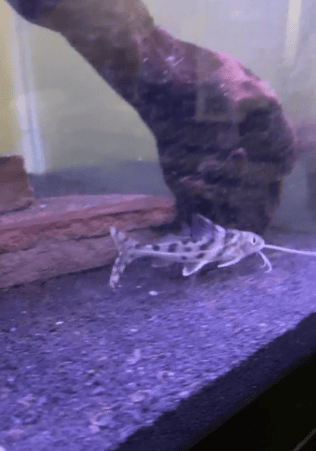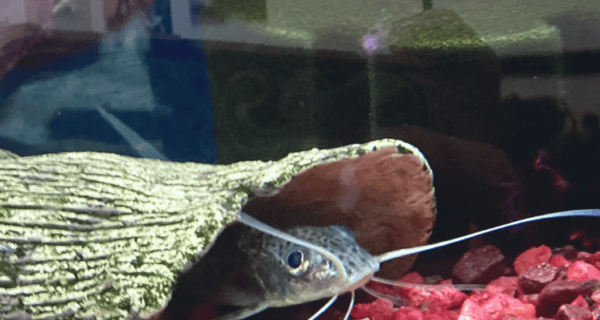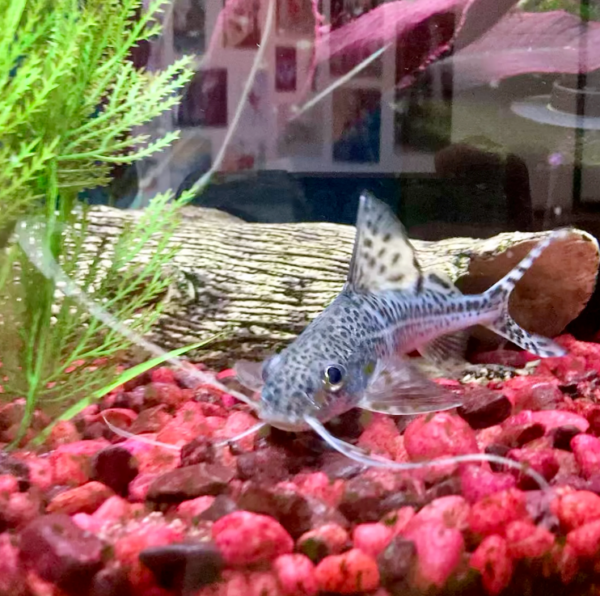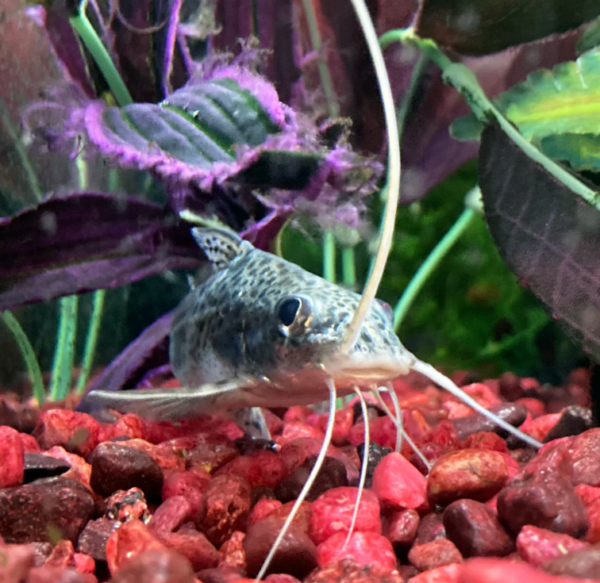Discovered in the warm freshwater rivers and streams of South America, Pictus catfish are native to Brazil, Venezuela, and Columbia. This nocturnal species of catfish is more populous in Amazon and Orinoco River basins.
Frequently demonstrating playful traits, the Pictus catfish are widely popular around the globe for their striking appearance and easy care needs. In addition, they often exhibit unique behaviors, such as simulated chase, that are amusing to watch.
In this article, we’ll go through the labyrinths of Pictus catfish care and understand the fundamental requirements of keeping a healthy Pictus colony in depth.
Table of Contents
Pictus Catfish Overview
Pictus catfish belong to the Pimelodidae family and are peaceful freshwater fish species. They’re often kept in community tanks as bottom-dwellers to scavenge uneaten food and other organic matter. While they don’t grow to a great length, they require a substantial tank size to fulfill their active swimming needs.
Not to the same extent as Upside-Down catfish, but the Pictus also often swim invertedly to feed on algae and biofilm grown on the undersides of the rocks and filters. As an aquarist, don’t be concerned with such sporadic behaviors and confuse it with swim bladder disease.
| Information Chart | Pictus Catfish |
| Scientific Name: | Pimelodus pictus |
| Family: | Pimelodidae |
| Care Level: | Moderate |
| Temperament: | Peaceful. But becomes aggressive during feeding time. |
| Color: | Silver-gray body with stripes and dark spots all over the body. Even on the fins. |
| Lifespan: | 8 to 10 years |
| Size: | 4 to 6 inches |
| Diet: | Omnivorous, but reliant on protein. |
| Minimum Tank Size: | 55 gallons for a small group |
| Temperature: | 75 to 82F |
| WaterConditions: | pH: 6.5 to 7.5 Hardness: 5 – 15 dGH |
| Tank Mate Compatibility | Small or medium-sized peaceful community fish. Other non-aggressive catfish. |
Pictus Catfish Appearance
Promoting a streamlined appearance and elongated body, the Pictus catfish has a somewhat flattened body, covered in small silver or gray scales—giving it a metallic sheen and shiny appearance.
Their most unique feature, appearance-wise, is their dark stripes and spots all over their body. These spots are irregularly distributed and also cover their fins and head.
Other notable attributes of Pictus catfish are their long, sensitive barbels that extend from their mouth area. These barbers help them locate food and danger in the surrounding area.
In addition to regular dorsal fins, pectoral fins, and anal fins, this species of catfish has a small fleshy adipose fin.
Types of Pictus Catfish
A couple of variants of Pictus catfish have been found in the wild. While they’re pretty similar in nature and appearance, a few traits differentiate them.
- Colombian Small-Spotted Pictus
The Pictus catfish from Colombia is a bit smaller in size and has smaller spots throughout its body, including the head.
- Peruvian Large-Spotted Pictus
The Peruvian variant has larger spots on its body and smaller spots on its head. This variant also is a bit larger than the Colombian one.
In addition, The albino Pictus catfish is a rare variety that has a white body and pink fins.
Lifespan of Pictus Catfish
With proper filtration, space, and nutrition, your Pictus catfish can live up to a grandiose 10 years in captivity. However, their average lifespan in the wild revolves only around 5-7 years.
Maximizing the lifespan of your Pictus requires you to:
- Maintain water quality: Pictus are susceptible to diseases caused by contaminated water. Employ powerful filtration systems and facilitate regular water changes to provide them with clean water.
- Tank Size: Give your Pictus catfish enough space to swim and play.
- Diet: Pictus are predatory fish and have an omnivorous diet. Sinking pellets, frozen food, and live food are suitable options.
Pictus Catfish Size
A regular adult Pictus catfish can grow up to a size of 6 inches in captivity. While we’ve seen a few grow a bit larger, that’s unusual and not expected.
Tank size, water quality, stress, and genetics are the greatest contributing factors that determine the size of Pictus catfish.
You must provide your Pictus colony with adequate tank space, proper water quality, and reduced stress. To reduce stress, aim to include decorations and plants for the fish to hide. Not having natural predators around also helps to calm them down.
Pictus Catfish Natural Habitat
In their natural tropical habitat, the Pictus catfish inhabit freshwater rivers with muddy and sandy substrates with lots of vegetation for them to hide. They prefer moderate water currents and constantly flowing rivers to live and breed.
They also are acclimated to a faster water flow in the rivers during the summer and monsoon. Therefore, if you must use a powerful filter, your Pictus can withstand a faster current without any discomfort.
Their natural predators include birds, other large fish, and reptiles, and they prefer to snack on invertebrates, shrimps, and small crustaceans. Sandy river beds allow them to bury themselves to ambush their prey and confuse their predators.
Pictus Catfish Care & Tank Set-Up

Originating in the always-flowing freshwater rivers, the Pictus catfish thrive in clean, sweet water. Your tank setup should also reflect the same. In this section, we’ll discuss Pictus care and tank setup in more detail.
1. Pictus Catfish Tank Size and Specification
The optimum tank size and specification for Pictus catfish are:
Optimum Tank Size for Pictus Catfish
The recommended tank size for Pictus catfish is 55 to 70 gallons for 5-6 individuals, more if kept in community tanks.
We strongly advise against keeping Pictus in smaller tanks, despite them being low-bioload fish. They appreciate adequate swimming space and often get stressed in cramped or overcrowded spaces.
If you have a smaller aquarium, don’t also keep a single Pictus. They are social fish and prefer to swim in groups to reduce stress.
Tank Shape for Pictus Catfish
Rectangular tanks are most well-suited for Pictus catfish. With enough space for horizontal swimming and adequate depth for bottom-dwelling, they can lead a healthy life in the tanks with appropriate dimensions.
The standard size for a 50-gallon aquarium is 36”(L) X 18”(W) X 19”(H). However, you may also go for a bow-front rectangular shape that has more space in the bottom to accommodate Pictus catfish.
Filter Type
Traditional HOB filters or biopellet reactors paired with sponge filters should be enough for Pictus catfish. While you may employ a more powerful canister filter for the flow rate and additional filtration, they aren’t necessary for Pictus-exclusive tanks.
However, a flow generator may be required to match their preference for high currents if you’re using HOB or sponge filters.
Regular water change, however, is critical for Pictus catfish. Perform a 25-30% water change weekly and a monthly 90-100% water change with deep cleaning.
Keep a reliable water testing kit handy to regularly test the parameters to manage the water change schedules and filtration systems.
Substrate
As for substrate, our focus would be on imitating the river beds as closely as possible.
Therefore, sand is virtually the best substrate for Pictus catfish. Being bottom-dwellers and scavengers, your Pictus will appreciate the use of sand as a tank substrate. Soft sand also prevents injury and allows them to exhibit their burrowing behavior.
However, if you must use gravel or pebbles, ensure that they are smooth and have no rough edges.
For planted tanks, sand-covered soil works exceptionally well for Pictus catfish.
How many Pictus Catfish can be kept in a 55-gallon tank?
A group of 4-66 Pictus catfish can be kept in 55-gallon tanks.
2. Water Parameters for Pictus Catfish
If anything is more important than the tank size, it’s water parameters. Owing to being extremely sensitive to chemical and temperature spikes, we need to maintain consistent water parameters and quality.
Water Temperature
Except for El Nino and other climate-related adversities, Pictus catfish seldom experience temperature spikes in the wild. Therefore, they prefer a consistent temperature of around 27 C or 80 F.
However, they can withstand a few degrees of deviation. Here are a few tips on how you can maintain your aquarium water temperature:
To raise the weather temperature:
- Get a thermometer.
- Use a thermostat-controlled heater or heat pad.
To reduce the temperature:
- Do regular water changes in the summer.
- Increase water flow at the surface and evaporation.
Water Flow Rate
Pictus catfish are accustomed to moderate to high water currents and prefer to swim against the flow. Therefore, aim for a water flow of at least 10 times the volume of water.
For example, if you have kept your Pictus in a 50-gallon aquarium, consider a filter or flow generator of at least 500 GPH. Pictus love to play in heavy currents and by the filters or bubble walls.
Place the filter in such a way that it doesn’t suck up the substrate or cause trouble to the small Pictus.
pH Level
A neutral pH level of 6.5 to 7.5 is well-suited for Pictus catfish. They are pretty sensitive fish that can’t withstand pH spikes. Therefore, maintain an optimal; pH level at all times by monitoring the tank and maintaining the water.
Irregular pH levels may cause issues in your fish like:
- Erratic swimming
- Gasping for air
- Rubbing their bodies into the rocks and substrate
- Development of ich and white spots
To raise pH:
- Use commercial pH accelerators.
- Use crushed coral in the filter or as a substrate
- Use plants that raise pH
To reduce pH:
- Do a water change with RO water.
- Use commercial pH buffers.
Water Hardness
A moderately soft pH of 5 -15 dGH is suitable to keep Pictus catfish. Irregular water hardness can hinder the natural osmoregulation process and gill function, and cause stress.
A few symptoms that indicate irregular water hardness, are:
- Loss of appetite.
- Gill clamping. Gasping for air.
- Increased mucus production.
- Skin lesions and lethargy.
Use RO/DI water, driftwood, crushed corals, or plants to maintain the water hardness. In many places, tap water sources change pretty often. If using, aggressively monitor the hardness before each water changes.
3. Pictus Catfish Tank Landscape
Pictus catfish prefer having dense vegetation and lots of hiding spots in their habitat. We’ll try to mimic the same through this section.
Best Plants for Pictus Catfish Tanks
The best aquarium plants for Pictus catfish include:
- Anubias: Hardy plants with sturdy leaves and roots. You may also anchor them to the driftwood.
- Java Fern: Hardy plants with thick leaves. Less likely to be disturbed by Pictus.
- Amazon Sword: Can withstand a high degree of disturbance.
- Cryptocoryne: Plant with a robust root system and well-suited for bottom dwellers.
Worst Plants for Pictus Catfish Tanks
There aren’t any specific plants that are harmful to Pictus catfish. But, a few types of plants are ill-suited for Pictus tanks:
- Carpeting plants: Plants such as Dwarf baby Tears and Monte Carlo can be uprooted by the Pictus catfish when bottom-dwelling.
- Floating plants: Floating Duckweed or Water Lettuce may provide cover to the Pictus, but they often misplace them.
- Plants that require high light: Pictus catfish are nocturnal creatures and they prefer dim lighting throughout the day. Plants with high light requirements can’t survive the environment.
Decorations for Pictus Catfish Tanks
Suitable decorations of Pictus catfish are:
- Driftwood: Natural hiding spot for Pictus catfish.
- Rocks and caves: Stable rocks and caves can offer a safe retreat to your Pictus.
- Ceramic caves
- PVC pipes: Provides easy hiding spots for Pictus catfish. Smooth the edges before using.
- Coconut shells: Adds a tropical touch to the aquascape and offer cozy hiding space for your Pictus.
Lighting for Pictus Catfish Tanks
Moderate to low lighting for 8-10 hours and darkness for the rest mimics their natural river environment. Being nocturnal creatures, meaning they’re more active at night than daytime, moonlighting lights are well-suited for Pictus tanks during the night time.
Dimmable lights can also be pretty effective for Pictus catfish. We often see them being more active at night when the aquarium lights are off, but the room lights are still on.
Feeding Pictus Catfish
Moving forwards, we’ve reached the nutrition part. Pictus catfish are omnivorous fish with a preference for a protein-based diet.
Best Diet for Pictus Catfish
A diet with multi-nutritional commercial pellets or flakes with occasional treats of live or frozen food (such as bloodworms or daphnia) is essential.
Our group of Pictus catfish loves cichlid flakes. While it may not work for you, it doesn’t hurt to try in the absence of catfish-exclusive pellets.
How often should you feed Pictus Catfish?
Pictus catfish are scavengers and don’t need to be fed too frequently if kept with other messy eaters.
However, if you’re keeping them alone, you may need to feed them once every day when they’re juvenile and once every two days when they’ve grown up. You may also limit their portion size to feed twice a day in the initial stages.
Pictus Catfish Tank Mates
Pictus catfish are pretty peaceful and playful creatures. They don’t prefer to be left alone without their own or other species in their proximity. A few species that make the ideal tank mates are:
Ideal Pictus Catfish Tank Mates
Any peaceful community fish are well-suited for Pictus. Tetras, other catfish, Gouramis, and small cichlids are particularly ideal choices. In addition, Danios, Rasboras, and Rainbowfish can also be kept with them.
Bad Tank Mates for Pictus Catfish
Aggressive and predatory fish are most ill-suited with Pictus catfish. Bottom-dwelling aggressive fish and fin-nipping fish species also can harm your Pictus or compete for food.
Other than that, species with very different water parameter requirements or very fast swimming abilities may make your Pictus uncomfortable.
A few of them are:
- Tiger Barbs
- Serpae Tetra
- Oscar Cichlids
- Bala Sharks
- Clown Loaches
- And others
Pictus Catfish Common Diseases and Their Treatment

Common Pictus diseases include parasitic and bacterial infections and stress-related issues. Some of them are:
Ich
Commonly known as ‘white spot disease’, Ich resembles grains of salt on the fish’s body and fins. The best course of treatment involves isolation, correction of water parameters, and water change.
Fin Rot
Fin rot is a bacterial infection that causes deterioration of fish’s fins and tails. Treatment involves isolation, anti-bacterial medication, and less stressful conditions.
Columnaris
Identified by cotton-like growths on the fish’s body and fins, Columnaris is a bacterial infection known as ‘cottonmouth’ disease. Treatment includes isolation, anti-bacterial medication, and water quality improvement.
Dropsy
Symptoms of underlying kidney or other organ issues, dropsy is identified by a swollen abdomen and fluid retention. The scales on your Pictus may also seem raised. Treatment includes consulting a vet and treating underlying health conditions.
Facts about Pictus Catfish
- Barberls of Pictus catfish resemble cat whiskers, thus the name.
- Pictus are highly active swimmers and often dart around the aquarium.
- They’re skilled jumpers and may jump out of the tank without the safety of a lid.
- Pictus catfish are skilled predators and can find small prey living in the substrates.
- Their strong pectoral fins help them navigate the fast-flowing rivers in monsoon.
FAQ
Yes, they can eat other small fish and fry if hungry. While they don’t actively seek small fish as prey, they can eat them.
It’s advised to keep at least 3-4 Pictus catfish in the tank. They’re social animals and prefer the safety of a group rather than living alone.
While not advised, you can keep Pictus with Goldfish. However, avoid Goldfish species with long, flowy fins.
The Bottom Line
Hopefully, you’ve gathered enough information from this article to be able to give proper care to your Pictus catfish. Ensure proper water quality, nutrition, and safety to keep a group of happy Pictus.
No related posts.


